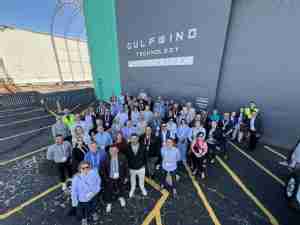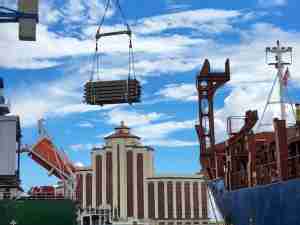Officiated by Vice-Premier Mr. Li Keqiang, the ceremony was attended by the Vice-Chairman of the National Development and Reform Commission, Mr. Zhang Xiaoqiang; the Secretary of the Chinese Communist Party Guangdong Provincial Committee, Mr. Wang Yang; the Governor of Guangdong Province, Mr. Huang Huahua; the Chief Executive of the Hong Kong Special Administrative Region, Mr. Donald Tsang; and the Chief Executive of the Macao Special Administrative Region, Mr. Edmund Ho Hau-wah.
The bridge consists of three parts, including the main bridge, boundary crossing facilities of Hong Kong, Zhuhai and Macao, and link roads of the three places. A 29.6-kilometer (km) main bridge will be jointly constructed by the three places. The designed vehicle speed is 100 km per hour.
To the west, the bridge lands on the artificial island off Gongbei, and to the east, it lands on the eastern artificial island for the tunnel section. It will be built according to six-lane expressway standard. For the main navigation channels like Lingding Channel and Qingzhou Channel, it will be in the form of tunnels. Two artificial islands will also be constructed to provide change-over facilities between bridge and tunnel to ensure that the traffic capacity of the key shipping channels towards Guangzhou and Shenzhen ports will not be affected.
The bridge will be one of the most technically complicated landmark projects in China's transport history. It is designed to last 120 years. The whole project will take about six years to complete.
The HZMB is of special strategic value in further enhancing the economic development of Hong Kong, Macao and the Western Pearl River Delta region (Western PRD). It will significantly reduce the cost and time for travelers and for the flow of goods between Hong Kong and the Western PRD, accelerate the economic integration of the PRD and its neighboring provinces, and increase its competitiveness vis-à-vis countries of the Association of Southeast Asian Nations and other economic zones such as the Yangtze Delta region.
Based on the consensus reached earlier over the funding arrangement of the project, the Central People's Government and the three governments will take up the responsibility for the construction of the Main Bridge. The Mainland will be contributing a total of RMB 7 billion. Hong Kong and Macao will contribute RMB 6.75 billion and RMB 1.98 billion respectively. The remaining cost will be financed by a consortium with Bank of China as the lead bank to provide loans.
Regarding construction works within the Hong Kong territory, the proposed boundary crossing facilities will fit in with the HZMB Main Bridge, the Hong Kong Link Road and the Tuen Mun-Chek Lap Kok Link, which will form a strategic road network connecting Hong Kong, Zhuhai, Macao and Shenzhen. The proposed works had earlier been approved by the Environmental Protection Department and meet the requirements of the Environmental Impact Assessment Ordinance.
The Highways Department has been pushing forward the design of the Hong Kong boundary crossing facilities and the Hong Kong Link Road. To tie in with the time table of the HZMB project and to allow detailed design of the HKBCF to begin next year, the Highways Department co-organized an international design ideas competition with related departments and professional institutions to draw innovative ideas and concepts to make HKBCF a new landmark in Hong Kong. The Highways Department has started the detailed ground investigation works for the Hong Kong boundary crossing facilities project. The works will provide essential geotechnical data for the detailed design of the Hong Kong boundary crossing facilities.
Hong Kong Secretary for Transport and Housing, Ms. Eva Cheng; the Permanent Secretary for Transport and Housing (Transpor









